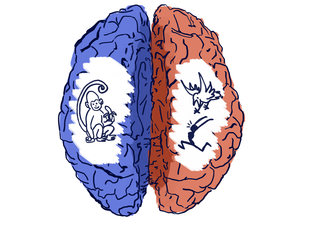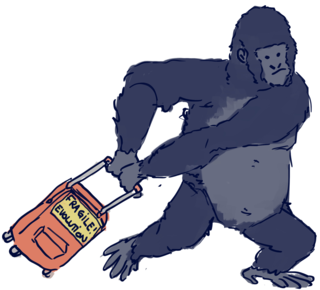
Environment
My Two Brains: Why Are They Not the Same?
Left and right brain differences have a long evolutionary history.
Posted February 5, 2019
We are all unique individuals, but we acknowledge that we might have inherited grandma’s nose or dad’s extroverted personality. Have you ever thought about what physical and psychological traits humans, as a species, have inherited from our ancient ancestors?
Because we are exceptional in our ability to think and act in ways unlike any other animal on the planet, it is easy to forget that modern human abilities have origins in a shared evolutionary history.
Although bipedal and comparatively hairless, we are great apes. We are not outliers as great apes either. We are genetically closer to chimpanzees than chimpanzees are to gorillas. As such, we share many brain and behavior traits with our great ape cousins.
But, our similarities to other animals date back much farther in time than our split with an ancestor common to both humans and great apes (approximately 6 million years ago). Some brain and behavior traits date back over 500 million years—present in early vertebrates and preserved in modern humans.
One of our oldest inherited traits is the ‘divided brain’. While the left and right halves of the brain (hemispheres) appear physically similar, they are in charge of different behaviors.

Traditionally, a divided brain was a characteristic considered unique to humans and directly associated with our exceptional human cognitive abilities, like language. However, more recently, animal studies have highlighted that fishes, reptiles, amphibians and mammals also possess left and right hemispheres that differentially control certain behaviors. The divided behaviors of these animals provide a window into our ancestral past, telling the story of our shared evolutionary history with early vertebrates.
Vertebrate studies suggest that the right hemisphere emerged with a specialisation for recognising threats in the environment and controlling appropriate response behaviors (e.g fight or flight), and the left hemisphere emerged as dominant for producing motor action sequences for critical behaviours like feeding (as pictured above). The divided brain allows for any organism to obtain nourishment whilst keeping alert for predators. We can think of the brain as acting like an ‘eat and not be eaten’ parallel processor.
How do we know?
Because the left and right hemispheres control physical behavior on the opposite side of the body, we can see these dominances revealed in the everyday actions of animals (including humans). Across species, there is a significant preference to use the left eye (in side-eyed animals) or the left visual field (in front-eyed animals) to watch out for threats in the environment. This includes predators and any novelty that could spell danger and the need for a quick escape strategy. Conversely, there is a significant preference to use the right eye (in side-eyed animals) or the right visual field (in front-eyed animals) for feeding behaviors.
Seminal studies of chicks demonstrated that the left eye is preferred for sorting grain from pebbles (sequences of motor actions) while the right eye is preferred for watching for predators (threat in the environment). The two tasks are simultaneously compatible (as pictured below).

The division of labour between the two hemispheres is an efficient use of brain space. If all processes were duplicated across both hemispheres, the animal would run the risk of both hemispheres competing to control behavior—but executing incompatible responses. Chicks bred to possess weak hemispheric dominances adequately performed individual tasks without eye preferences, but were poor at performing tasks simultaneously—which does not bode well for survival.
In mammals (e.g. dogs, monkeys) the primitive self-preservation activities of the left and right hemispheres are extended. Mammals demonstrate social capabilities that build on the right hemisphere dominance to perceive dangerous predators. These species prefer to monitor group members with a left gaze preference.
Humans extend this capability even further. As a population, we are quicker and more accurate at recognising individual identities and their associated emotional expressions when presented to the left side of space—dominantly controlled by the right hemisphere.
Considering the consistency in hemisphere specialization across species, it seems likely that there has been a preservation of a right hemisphere dominance for processing social stimuli that became more sophisticated along an evolutionary continuum. Effectively, we have lugged these early brain and behavioral traits with us throughout our evolutionary journey (as pictured below).

However, little is known about the origins of our social abilities because modern psychology is often too entrenched in considering human brains and behavior isolation of a shared evolutionary history inhibiting a better understanding of how, when and why our human capabilities arose. It is our similarities and differences to other species that allow us to better understand how we came to be modern humans.
Why should we care?
Humans possess truly amazing, modern behaviors. However, these behaviors are still underpinned by evolutionarily old left and right hemisphere dominances because evolution innovates on the periphery. Through evolution, old neural mechanisms do not get rebuilt from the ground up. Rather, the old mechanisms remain in place and act as a platform for extensions. Sometimes extensions create behaviors that look nothing like the activity for which the original mechanism was intended. As a result, the new ability can only be understood with knowledge of the purpose of the original mechanism.
As modern humans, old right hemisphere specialisations still support some of our most intimate behaviors—like the way we navigate social environments, kiss, embrace, nurture babies—and even take a selfie! Old left hemisphere specialisations fortify some of our most sophisticated capabilities like tool use and language.
In forthcoming blogs, I will explore ancient catalysts for modern human abilities. I will also discuss how an improved understanding how cognitive abilities that arise through evolution may hold the key to a better understanding of how infants gain abilities through development.
Me, Human blog posts aim to highlight our similarities and differences with other species in order to better understand the origins of human abilities and our place within the natural world.
References
Perelman P, Johnson WE, Roos C, Seuánez HN, Horvath JE, et al. (2011) A Molecular Phylogeny of Living Primates. PLoS Genet 7(3): e1001342. doi:10.1371/journal.pgen.1001342
Rogers LJ, Vallortigara G, Andrew RJ (2013) Divided brains. The biology and behaviour of brain asymmetries. New York, NY: Cambridge University Press.
Forrester GS, Hudry K, Lindell A, Hopkins WD, eds. (2018) Cerebral lateralization and cognition: evolutionary and developmental investigations of behavioral biases. Progress In Brain Research 238. Elsevier (p. 378).
Rogers, LJ (1995) The Development of Brain and Behaviour in the Chicken. CAB International, Oxford, UK.
Guo K, Meints K, Hall C, Hall S, Mills D (2009) Left gaze bias in humans, rhesus monkeys and domestic dogs. Animal cognition, 12 (3): 409-418.
Finlay BL (2007) Endless minds most beautiful. Developmental Science, 10: 30–34.



